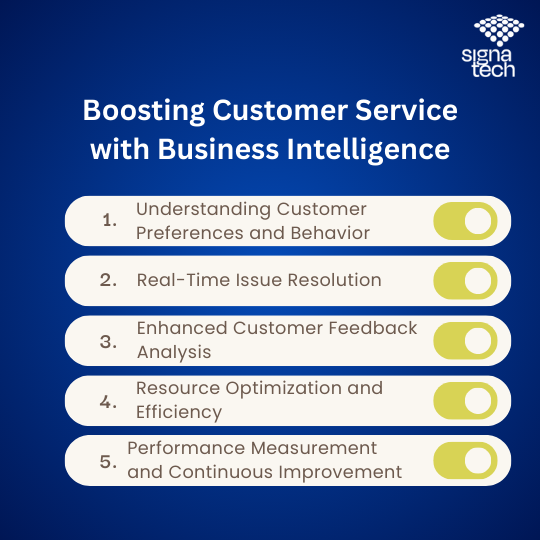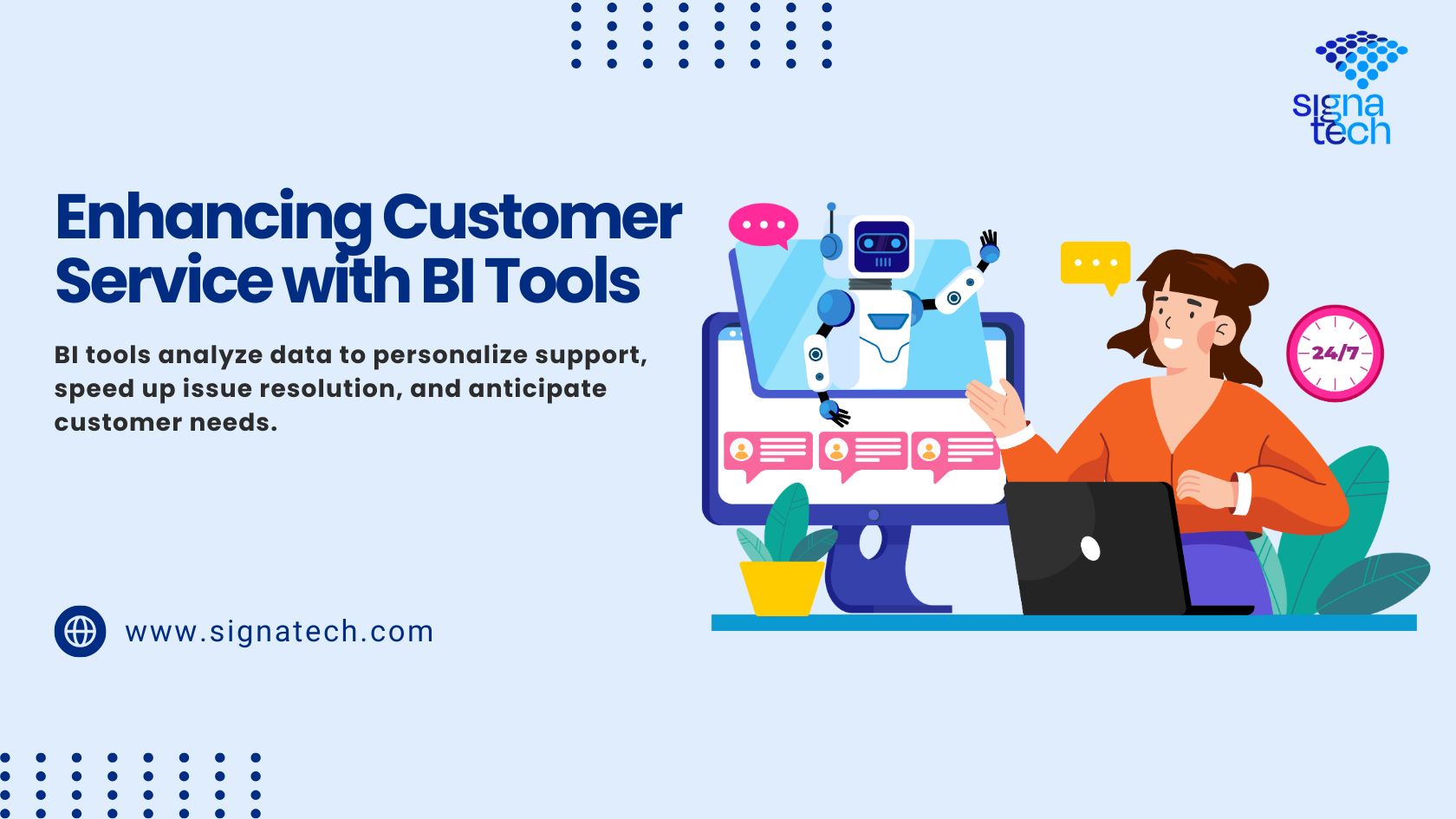Sustaining customer satisfaction and loyalty requires excellent customer relations to be in place. In the aspect of service, organizations are now using Business Intelligence (BI) systems in order to understand the needs and respond to customers’ needs in the course of interacting with them, ultimately enhancing the customer service experience with business intelligence.
BI tools gather data from different points of contact and provide information that enables companies to make the right decisions. It also helps businesses to give appropriate responses, predict customers’ needs, and solve problems to improve the customer experience.
With the development of BI tools, they are now mandatory for a customer-oriented strategy. Converting data into useful information, these tools enable companies to create sustainable partnerships and differentiate themselves through data-driven services.
Now, before we go ahead and discuss the topic in detail, it is important to have a clear idea about what a Business Intelligence tool is.
What is a Business Intelligence Tool?
BI tool is an application that is used to collect, process, and present information to help the organization make the right decisions and implement the best plans. Combining data from different sources, including the sales report, customer feedback, and market trends, BI tools convert raw data into valuable information that can be used to monitor performance, look for patterns, and make suitable changes, enhancing the customer service experience with business intelligence. Some of the features that are shared include data representation, dashboard, and self-generation of reports, which help the teams understand complex data and track performance in real time.
BI tools such as Tableau, Power BI, and Looker enable organizations to make the right decisions to enhance operational efficiency, customer satisfaction, and business performance. Everything from predicting sales to managing supply chains relies on these tools for effective support of strategic planning and operational performance. Because data becomes an organizational asset through BI, organizations can remain relevant and adaptable within a dynamic environment.
Having discussed what Business Intelligence is, it is now time to look at how these tools are improving customer service.
Enhancing customer service experience with business intelligence tool

Understanding Customer Preferences and Behavior
The BI tools enable organizations to capture and analyze large amounts of customer data from different touch points including the website, purchase behavior, social media and customer service interactions. Through the integration of such data, BI tools help in the analysis of customer’s behavior and purchasing habits as well as their level of interaction. This increases the customer satisfaction since the recommendations, solutions and services being offered by the business are unique to the individual customer.
Real-Time Issue Resolution
Thus, promptness is one of the most important factors in the sphere of customer service. BI tools allow for real-time tracking, thus issues affecting customers can easily be detected and handled, enhancing the customer service experience with business intelligence. Real-time dashboards give a detailed picture of the customer queries that are coming in and which of the cases require attention. With this information, service agents can quickly attend to urgent requests, reduce response time, and prevent small problems from becoming big issues, improving customer satisfaction.
Predictive Analytics for Proactive Service
Predictive analytics, powered by BI tools, enable customer service teams to anticipate potential issues and proactively engage with customers before problems arise. By analyzing patterns in past data, BI tools can identify signs of customer dissatisfaction or potential service needs, allowing teams to take preventative action. For example, if a particular product consistently leads to customer complaints after a specific time, predictive insights can prompt preemptive support measures, reducing potential issues and boosting customer retention.
Enhanced Customer Feedback Analysis
BI tools help customer service teams solve problems by using predictive analytics to foresee issues and approach customers before the problems emerge, enhancing the customer service experience with business intelligence. BI tools can also look for patterns in previous data to recognize any signs of customer discontent or possible service requirements, so that action can be taken. For instance, if a specific product causes customers to complain after a certain period, predictive analytics can alert staff to provide support before the customers develop problems, thus retaining customers.
Resource Optimization and Efficiency
BI tools help in managing resources; the number of employees that need to be hired for customer service depends on historical usage. BI tools are useful in the identification of peak periods, average query volume and the types of issues that are frequently reported which aid in resource assignment. This optimization not only decreases the time taken by the customers to be attended to but also decreases the costs of operation. BI tools also provide data on performance of the agents, where more training or support is required, so as to maintain a healthy blend of the service team.
Performance Measurement and Continuous Improvement
In order to ensure that the service being delivered is good enough, certain parameters such as response time, rate of closure, and customer satisfaction ratings should be monitored and evaluated. BI tools give real-time information on these metrics to help the management evaluate the efficiency of their service strategies, enhancing the customer service experience with business intelligence. By having access to the specific metrics, customer service managers can establish targets, define development opportunities, and offer training, helping the team in their desire to always evolve.
Enhancing Cross-Departmental Collaboration
BI tools are designed to help organizations to share customer data between the customer service, marketing, sales, and product development teams. Through the provision of customer feedback and service data, BI tools help in the synchronization of goals and strategies of different teams leading to a coherent approach of handling customers. For instance, a data set that gives information on questions customers often ask can assist the marketing arm in creating better content, or feedback data can assist product teams in making specific changes.
Enabling Self-Service Options
Today’s customers expect to resolve problems on their own using self-service mechanisms. BI tools assist in enhancing and sustaining efficient self-service tools such as knowledge bases and customer portals since the usage is monitored for insight, improving the customer service experience with business intelligence. BI tools can provide information on which articles or other resources are most beneficial, allowing content to be adapted to provide more value to customers. Additionally, with BI, the information provided by chatbots can be more accurate and timely, helping customers solve problems independently and freeing up the work of customer support specialists.
BI tools have become a necessity for organizations that want to improve the customer service delivery by analyzing data and making early decisions. When applied properly, these tools help organizations capture all necessary information about the clients, improve their interactions and foster long term cooperation, resulting in customer satisfaction.
If you are looking for ideas on how you can improve your customer service with professional help, Signatech presents Business Intelligence Consulting Services. Still unsure? Oh no, don’t worry – we’re here to help, and our team is just a click away. Contact us today and let us explain to you how Business Intelligence can help to revolutionize your Customer service experience.
